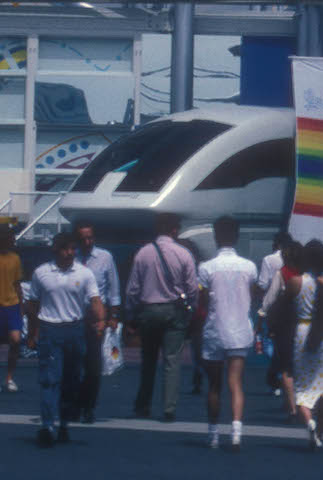Sunday, July 27, 1986.
TO THE AVERAGE CITY-dwelling North American, railroads are the stuff of folk songs and 19th-century national dreams.
To the European, though, they are an immediate mass transporter, a dynamic industry and a vital technology.
On the Continent, the iron horse is the once and future people mover. Expo visitors can get some sense of its importance from the many train-oriented films and video presentations vying for attention at the various European pavilions.
Both France and Germany are out to impress fairgoers (and potential government purchasers) with their own technological sophistication. To that end, France offers a continuous multi-screen video presentation in a theatre space that replicates the TGV control room in Paris’s elegant Gare de Lyon.
In regular passenger service between the cities of Paris and Lyon, the TGV (Train Grand Vitesse, or High Speed Train) holds a world speed record of 330 km/h (236 mph). The film documenting its record-setting run includes a remarkable scene in which the TGV is seen passing a low-flying aircraft.
In the German pavilion, a 12-screen telewall is devoted to that nation's rail technology. The Germans also have a special 8½-minute video presentation available to special — read business — groups explaining the Transrapid, the amazing electromagnetic levitation vehicle currently under development by Thyssen Henschel.
Rail tourism is promoted in the British pavilion by means of a back-projected film. Located behind a mock-up of a BritRail ticket counter, the movie screen offers a selection of scenic views, a silent presentation complemented by television monitors displaying continuous footage of trains moving about the picturesque isles.
In an even more playful mood, Italy invites visitors to its pavilion to play the “Train Game.” Seated at the controls in a simulated electric engine cab, players look out over a rapidly moving back-projected right-of-way.
The above is a restored version of a Province review by Michael Walsh originally published in 1986. For additional information on this archived material, please visit my FAQ.
Afterword: Readers in 1986 would have recognized the phrase “stuff of folk songs” as a reference to Arlo Guthrie’s 1972 hit single, The City of New Orleans, an evocative lament for the decline of passenger rail travel in the U.S. “National dreams,” of course, brought to mind Canadian popular historian Pierre Berton’s 1970 best-seller, The National Dream, and its sequel, The Last Spike (1971). In them, Berton told the story of how the Canadian Pacific Railroad linked the nation in1885. His books became the subject of a hugely popular eight-hour TV miniseries, The National Dream, aired by the CBC in 1974. Nostalgia notwithstanding, the reality of railways in Expo’s year was best reflected in director Arthur Hiller’s 1976 feature comedy, Silver Streak, a movie that ends with a train wreck in Chicago’s Union Station.
The Europeans' apparent enthusiasm for their trains ran counter to the prevailing North American attitude that railroads were a quaint artifact of our sepia-toned past. In the mid-20th century, the cultural emphasis had moved on to personal independence in an economy based on automobile manufacturing. The post-Second World War interstate highway construction boom came together with relatively low-cost air travel to sideline public interest in or support for passenger rail transportation. In the U.S. and Canada railroads were privatized where corporations sensed potential profit, but otherwise neglected and abandoned.
Although such ideas of modernity were certainly influential overseas, the rest of the world’s nations hedged their bets, and maintained their rail systems. As Expo 86 made clear, genuine advances were coming along. Rail lines making use of high-speed and magnetic levitation (maglev) technology are part of the current transportation infrastructure in Europe and Asia. At the same time, ever-increasing road congestion and rising fuel costs, as well as pollution, climate change and airline security concerns, make a return to the rails here seem both smart and inevitable.
See also: The eight articles included in this, the third of four Expo 86 special reports, explore the pavilions of:
|
23: Expo 86 EEC/Germany 24: Expo 86 EuroSpace 25: Expo 86 EuroRail 26: Expo 86 Czechoslovakia |
